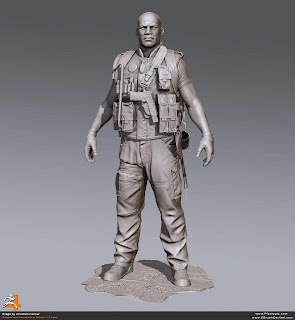Monday, December 6, 2010
Z brush
I thought id do a post on one of the 3d tools thats made the biggest impact to the character modeling/design industry in recent years. Pixolgic's Z brush is a digital sculpting software that came out in early 2000. The tools major advantage to traditional subdivision modeling methods. Their propitary method of subdividing lets the user work on a mesh in the millions and move through multiple levels of subdivision with ease. The user is able to move from their base mesh of mere hundreds of polygons to a million and still be able to sculpt directly onto the mesh without decreased performance. The program does this so well that you are able to sculpt skin details onto a character such as scales or pores. The program's other major advantage is the intuitiveness of the program. The tools relate more to traditional sculpting or painting than to computer based hard surface or nurb modeling. The system also allows your to "paint" details onto a mesh using alpha maps that you can make from any 2d program like photoshop. The system pairs very well with other programs like maya or 3dsmax, thereby improving the pipeline and streamlining workflow.
Helvetica
During class we watched the film Helvetica. The film is a full length documentry on typography, design, and visual culture. The film goes into all of the prolific effects the typeface has had on the world in the past 50 years. The film disects the areas of design, advertising, psychology, and communication. Helvetica interviews numerous respected designers such as Erik Spiekermann, Matthew Carter, Massimo Vignelli, Wim Crouwel, Hermann Zapf, Neville Brody, Stefan Sagmeister, Michael Bierut, David Carson, Paula Scher, Jonathan Hoefler, Tobias Frere-Jones to name a few.
Helvetica was created by Max Miedinger with Edüard Hoffmann in 1957 for the Haas Type Foundry in Münchenstein, Switzerland. Europe in the 1950s was seeing a revival of sans-serif typefaces. The typeface was introduced during a peak in popularity of Swiss design, and fueled by advertising agencies selling this new design style to their clients, Helvetica quickly appeared everywhere from logos to fine art. .
Helvetica was created by Max Miedinger with Edüard Hoffmann in 1957 for the Haas Type Foundry in Münchenstein, Switzerland. Europe in the 1950s was seeing a revival of sans-serif typefaces. The typeface was introduced during a peak in popularity of Swiss design, and fueled by advertising agencies selling this new design style to their clients, Helvetica quickly appeared everywhere from logos to fine art. .
Sunday, December 5, 2010
Artist profile: Frank Gehry
Frank Gehry is a renowned Architect based out of Los Angles California. His buildings including his own home have become some of the most recognizable structures in architecture and have become massive tourist attractions. Some of his more recognizable works are the Guggenhiem museum in Bilbao Spain, the Walt Disney Concert Hall in LA, and Dancing House in Prague. His work is in the style of deconstructionism, a style which goes beyond typical structural definition. There is no concept of form follows function, it is only aesthetics. This is something that is very interesting to me as typically architecture to me is a stagnant field that follows a rigid rule set that leaves aesthetics aside for a more functional grounding. Gehry's methodology takes advantage of the new world tools to realize his visions that would otherwise be impossible or implausible. I really relate to his drafting method as well, i like the way he messily sketches out forms with drawing and crumbled paper and scotch tape.
Subscribe to:
Posts (Atom)








